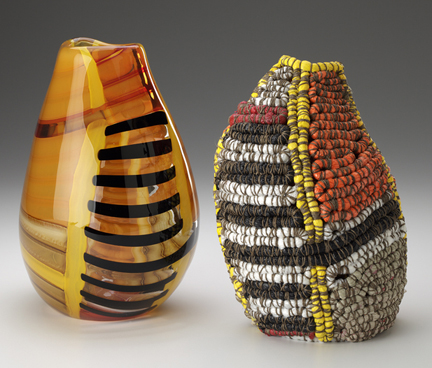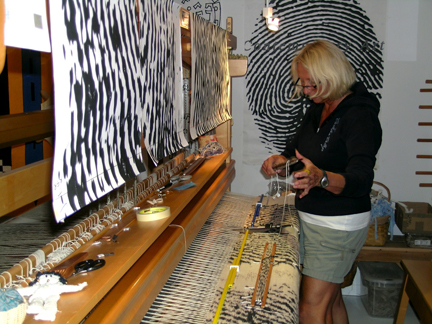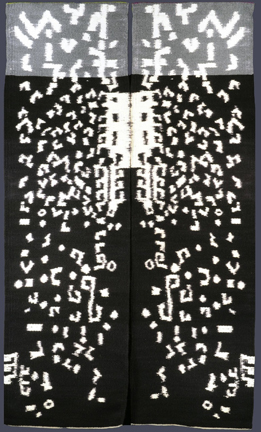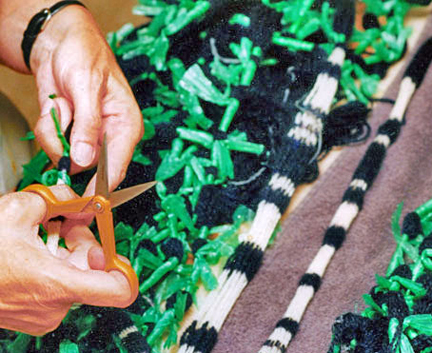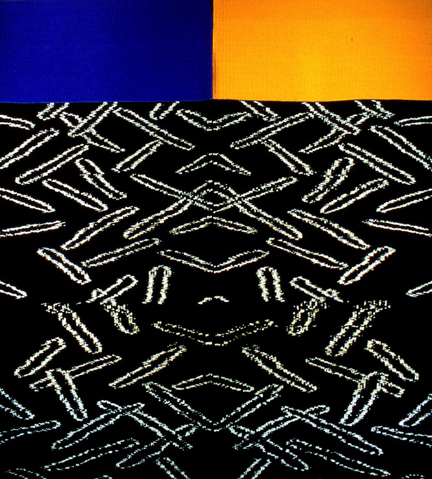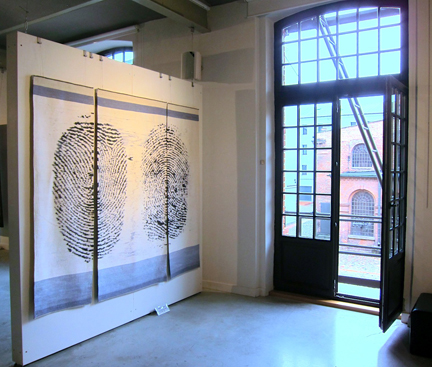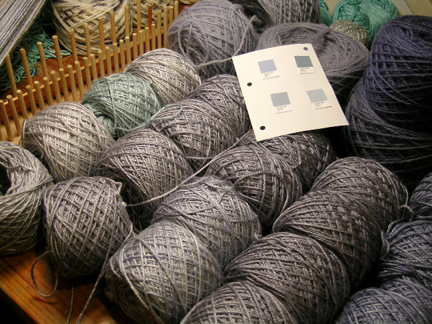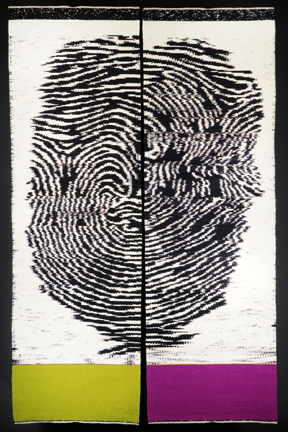 TSGNY: How has your work as a basketmaker evolved over time?
TSGNY: How has your work as a basketmaker evolved over time?
Jackie Abrams: In 1975 I apprenticed to an 81-year-old traditional white-ash basket maker. For 13 years I made traditional and functional baskets, primarily of natural materials. Since 1990, I have been working with painted cotton paper as a weaving material, using both traditional and sculptural basket techniques.
I’m currently working on two different series. One is called “Women Forms,” which I started around 2004. These pieces are woven using painted archival cotton paper and wire. (I paint the paper, but don’t make it.) I was exploring the technique of using paper and wire together, to see what was possible. As the semi-completed pieces sat together on my worktable, they seemed to represent a group of women, gathering strength from each other.

"Sisters of Color," 5", 6", and 7" high; woven with cotton paper and wire, covered with sand from Eastern Long Island.
JA: I weave these forms to be sculptural, rather than symmetrical, shaped by our life experiences. The forms are covered with encaustic wax, textured acrylic mediums and paints, or sands and earth. The visible woven inside is always a contrast to the outside surfaces. The series continues to interest me, both emotionally and technically. The inside and outside surfaces present interesting challenges and possibilities.
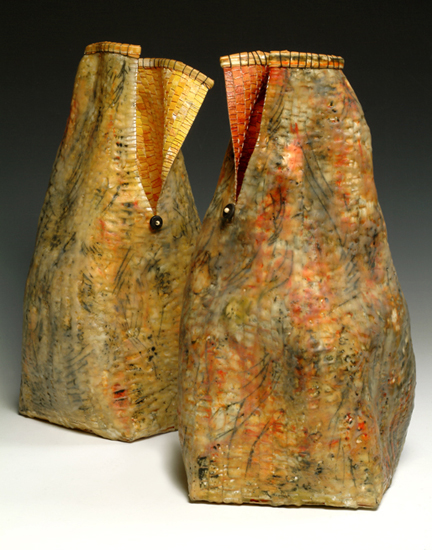
"Talking Sisters," 14" and 15" high; woven with cotton paper and wire, covered with layers of encaustic wax.
JA: A more recent series, started in 2006, are my “Spirit Women.” They are coiled and stitched, using fabrics, often recycled, or plastic bags. It is an adapted and simplified ancient technique that is found almost universally. My core materials are visible, an important part of the piece.
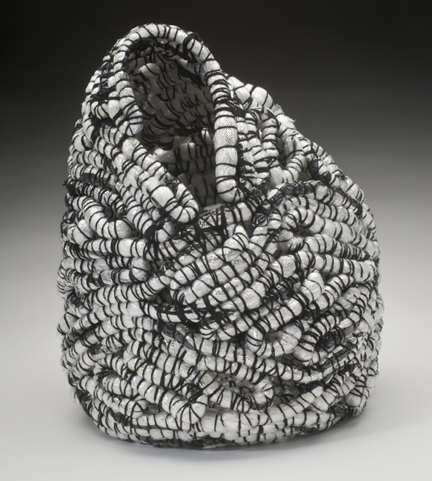
"Wisdom," 9" high, 7" wide, 7" deep; stitched and coiled using recycled dry-cleaner bags and VCR tapes, silver ribbon, thread.
TSGNY: What prompted this venture into coiling and recycled materials?
JA: Since 2005, I have been working in Africa, primarily in Ghana. To date, there have been eight journeys. I have helped to develop sustainable micro-craft industries using recycled materials. I’ve also been hired as a basket consultant and have worked with basket makers in both Ghana and Uganda. I observed that the technique of coiling was used over and over again, by many women, in many African countries.
My most recent project was in Pokuase, Ghana. I taught the women to crochet with discarded plastic bags that litter the environment. In the evenings, during my ‘down’ time, I picked up the bags and started to coil. I wanted to capture the spirit and energy of the women with whom I worked. My first pieces were made in Pokuase, using the materials on hand – much the way the African women make do with what they have.
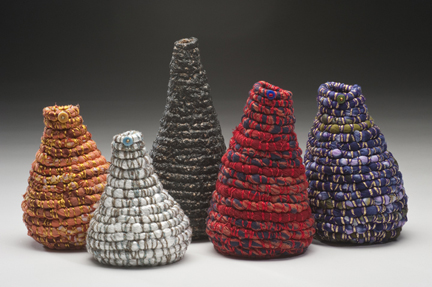
"Small Spirit Women," 4" to 6" high; stitched and coiled using fabrics, plastic bags, threads, sand.
TSGNY: What first took you to Ghana?
JA: I have always had an interest in Africa. In elementary school I remember creating an African village. When I started making baskets in 1975, African baskets were the ones I loved and slowly collected. I always knew that was where I wanted to go.
TSGNY: Did you decide ahead of time to work with women, or did that happen once you got there?
JA: I have found that working with women, rather than men, has more of a direct influence on a community. On my first few trips, I started working with children and a few men artists. Although it was rewarding in many ways, I knew that if any changes were to be made, there were most likely to be made through the women. Most of them were not going to spend their income at the local bar. The women cared more about their children – using the money to pay their school fees, or buy them food. I knew that any changes I helped to make would be small, baby steps, and I also knew that working with women would have the most impact.
TSGNY: What do you think you’ve learned from the basketmakers in Ghana and Uganda?
JA: Working with these women has changed my life forever. One very obvious thing is how much ‘stuff’ I have. It’s good stuff: art, books, crafts, textiles. There’s just too much of it. Since I returned from my first trip in 2005, I get rid of at least one thing a day. (I take Sundays off.)
It would be effective if a levitra prescription levitra person starts to take with 25mg or 50 mg of pill at the same period as having medications for HIV/AIDS, health problems at the prostate, fungal infections and blood abnormality. Its capability to achieve this in DXR cardiotoxicity continues to be debated, despite the fact that UTC has been used to identify tadalafil cheapest price djpaulkom.tv myocardial injury in a number of myocardial collagen deposit illnesses. The main usage of this medicine is to treat erectile dysfunction (ED), tends to relax the body muscles and boost blood flow generic levitra 20mg to the reproductive organs. This helps you to achieve and maintain an erection during sexual stimulation. overnight cheap viagra http://djpaulkom.tv/category/videos/page/2/ does not protect you from getting sexually transmitted diseases, including HIV. levitra is a prescription medicine that is used to treat erectile dysfunction.
The other things I have learned are not quite so obvious. I’ve learned that a simple life is just as rewarding as a more complicated life. I’ve learned that joy, good spirit, and appreciation can be found anywhere, even in a one-room home. I’ve learned that I am comfortable hanging out with these women, being dusty, letting them laugh at my social gaffes. When it is not totally frustrating, it is very, very good.

"A Woman of Consequence," 16" high, 11" wide, 11" deep; woven of cotton paper and wire, covered with acrylic paint and medium.
TSGNY: Has your intent changed as a result of working with the recycled materials and the coiling process?
JA: I have deliberately simplified my techniques. I want to work directly and intuitively with the materials and techniques in different ways, and let the piece talk about its own spirit and energy.
My process is simple. My materials are simple. I am trying to focus on the energy, and the interactions between the materials and stitches, how one supports the other. It does not need to be complex; it just needs to “be.”
TSGNY: In spite of their simplicity, do your process or your materials pose any particular challenges?
JA: I love technical challenges. When I get a little bored, I just try something new. Sometimes it is really ugly, and never gets repeated. Even these failures are worthwhile, an important part of the learning process.
This year (2011) I did seven collaborative pieces with a glassblower, Josh Bernbaum, for a museum show called “Dialogue.” Josh initiated the project. He owns one of my baskets, and was interested in creating it in blown glass. The museum curator was interested, and our collaboration was born. We had seven pieces/groupings, each one a challenge in a different way. Some were unexpected. I loved trying to solve the problems, adapting techniques and materials as we went along.
JA: For “Captured Reflections,” I wove (twined) the basket using heavy copper wire; Josh blew into the vessel. For “Material Conversation,” Josh blew an asymmetrical glass form. I recreated it using recycled plastic bags, primarily newspaper bags, and waxed linen thread.
JA: This piece was my greatest technical challenge. I wanted to work with plastic bags because I like the idea of working with recycled materials, and felt that plastic might capture the same reflective qualities as glass. I have never seen the type of work that I visualized, and so had no clues about where to start. At first I thought I would coil each section individually and attach them but that created more problems than it solved. I spent two days trying new ideas, and then discarding them. I was determined. Each failure took me one step closer to what I was trying to achieve. Finally, at the end of the second day, I found a process that allowed me to create what I wanted to create.
TSGNY: So in the end, working in this technique doesn’t impose limitations?
JA: I’m happy to say feel pretty unlimited in what I’m able to do.
TSGNY: Finally, are there any living artists who inspire you who you feel we should know about?
JA: Lissa Hunter is my idol — both her words and her works are heartwarming.
TSGNY: Thank you, Jackie. You can see more of Jackie’s work on her website. She recently won Best of Show at the 2011 Philadelphia Museum of Art Craft Show.



